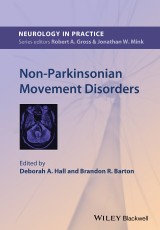Details

Non-Parkinsonian Movement Disorders
NIP- Neurology in Practice 1. Aufl.
|
63,99 € |
|
| Verlag: | Wiley-Blackwell |
| Format: | |
| Veröffentl.: | 27.12.2016 |
| ISBN/EAN: | 9781118474068 |
| Sprache: | englisch |
| Anzahl Seiten: | 224 |
DRM-geschütztes eBook, Sie benötigen z.B. Adobe Digital Editions und eine Adobe ID zum Lesen.
Beschreibungen
A clinical ‘in the office’ or ‘at the bedside’ guide to effective patient care for neurologists in practice and in training <br /> <ul> <li>Each presentation includes practical descriptions of phenomenology, and key clinical information from the history and neurological examination that guide the physician to the correct diagnosis, and treatment options</li> <li>Throughout the book <i>Science Revisited</i> highlights remind clinicians of the scientific anchors related to each disorder, and <i>Evidence at a Glance</i> boxes summarise clinical trial evidence-based review information </li> <li>Numerous video clips in every chapter demonstrate different movement disorders to aid diagnosis </li> <li>Unique learning tools, <i>Tips and Tricks</i> and <i>Caution Warning</i> boxes, give useful hints on improving outcomes and preventing errors </li> </ul>
<p>List of Contributors vii</p> <p>Series Foreword ix</p> <p>Foreword x</p> <p>About the Companion Website xi</p> <p>1 Approach to Movement Disorders 1<br /><i>Deborah A. Hall and Brandon R. Barton</i></p> <p><b>part 1: hypokinetic</b></p> <p>2 Hypokinetic (Non?]Parkinsonian) Movement Disorders 7<br /><i>Shyamal H. Mehta and Alberto J. Espay</i></p> <p><b>part 2: hyperkinetic</b></p> <p>3 Common Types of Tremor 17<br /><i>Jeff Kraakevik and Bernadette Schoneburg</i></p> <p>4 Myoclonus 26<br /><i>Daniel Burdick and Pinky Agarwal</i></p> <p>5 Tics and Tourette Syndrome 35<br /><i>David Shprecher</i></p> <p>6 Chorea, Athetosis, and Ballism 43<br /><i>Rohit Dhall</i></p> <p>7 Dystonia 57<br /><i>Lauren Schrock, Tao Xie and Brandon R. Barton</i></p> <p>8 Ataxia 68<br /><i>Samantha Holden and Deborah A. Hall</i></p> <p>9 Restless Leg Syndrome 79<br /><i>Olga Klepitskaya</i></p> <p>10 Hemifacial Spasm and Other Facial Movement Disorders 89<br /><i>Tao Xie, Ifeoma Nwaneri and Un Jung Kang</i></p> <p>11 Periodic Limb Movements of Sleep and REM Sleep Behavior Disorder 99<br /><i>Aleksandar Videnovic</i></p> <p>12 Stereotypies 106<br /><i>Michael Rotstein</i></p> <p>13 Paroxysmal Movement Disorders 114<br /><i>Christina L. Vaughan</i></p> <p>14 Uncommon Movement Disorders and Movement Disorder Mimics 121<br /><i>Nina Browner</i></p> <p><b>part 3: other disease syndromes</b></p> <p>15 Tardive Syndromes 133<br /><i>Stephanie Lessig</i></p> <p>16 Heavy Metal Accumulation Diseases 139<br /><i>Khashayar Dashtipour and Janice Fuentes</i></p> <p>17 ICU Intensive Care Unit Movement Disorder Emergencies 150<br /><i>Florence C. F. Chang and Steven J. Frucht</i></p> <p>18 Functional or Psychogenic Movement Disorders 161<br /><i>S. Elizabeth Zauber</i></p> <p><b>part 4: additional resources</b></p> <p>19 Genetics of Movement Disorders 171<br /><i>Deborah A. Hall</i></p> <p>20 Neuroimaging Finding in Movement Disorders 175<br /><i>Kathleen L. Poston</i></p> <p>21 Clinical Rating Scales in Movement Disorders 185<br /><i>Padmaja Vittal and Brandon R. Barton</i></p> <p>22 Videotaping Suggestions for Movement Disorders 190<br /><i>Gian Pal and Deborah A.</i> Hall</p> <p>Index 195</p>
<p><b>Deborah Hall, MD, PhD<br /></b>Department of Neurological Sciences, Section of Movement Disorders at Rush University Medical Center, Chicago</p> <p>Dr Hall was awarded her MD at Indiana University and completed her internship, neurology residency and movement disorders fellowship at University of Colorado. She is the recipient of an NIH K23 career development award to investigate the prevalence of FMR1 repeat expansions in various movement disorders. Her research interests are in Fragile X tremor ataxia syndrome and in clinical aspects of movement disorders.</p> <p><b>Brandon Barton, MD<br /></b>Department of Neurological sciences, Rush University Medical Center, Chicago</p> <p>Dr Barton splits his time between the Movement Disorders section at Rush University Medical Center and the Veterans Administration. Barton's research interests are in clinical trials in movement disorders, and in behavioral changes in Parkinson disease, particularly impulse control disorders.</p>
<p>Describing and differentiating the different tics, jerks, spams and tremors that present as movement disorders is frequently less than straightforward. Formulating a differential diagnosis to account for these movements, and to develop a treatment plan, is a further challenge.</p> <p><i>Non-Parkinsonian Movement Disorders</i> provides the tool kit you need to effectively identify the movement disorders your patients suffer. Starting from the various movement phenomena patients present with, and using clinically proven approaches, the stellar cast of authors provide a practical guide to diagnosis and management.</p> <p>Clearly divided into sections, the first section of this book contains a short chapter on non-parkinsonian hypokinetic movement disorders (parkinsonian disorders are covered in another volume in the <i>Neurology in Practice</i> Series), and the second section discusses hyperkinetic disorders. Section three covers various syndromes that do not fit into the other categories or that overlap between categories, and finally broader chapters on genetics, neuroimaging, rating scales, and videotaping suggestions serve as resources to the reader.</p> <ul> <li>Each presentation includes practical descriptions of phenomenology, and key clinical information from the history and neurological examination that guide the physician to the correct diagnosis, and treatment options</li> <li>Throughout the book <i>Science Revisited</i> highlights remind clinicians of the scientific anchors related to each disorder, and <i>Evidence at a Glance</i> boxes summarise clinical trial evidence-based review information</li> <li>Numerous video clips in every chapter demonstrate different movement disorders to aid diagnosis</li> <li>Unique learning tools, <i>Tips and Tricks</i> and <i>Caution Warning</i> boxes, give useful hints on improving outcomes and preventing errors</li> </ul> <p>Clinical in approach, practical in execution<i>, Non-Parkinsonian Movement Disorders</i> helps you better help your patients.</p>

















